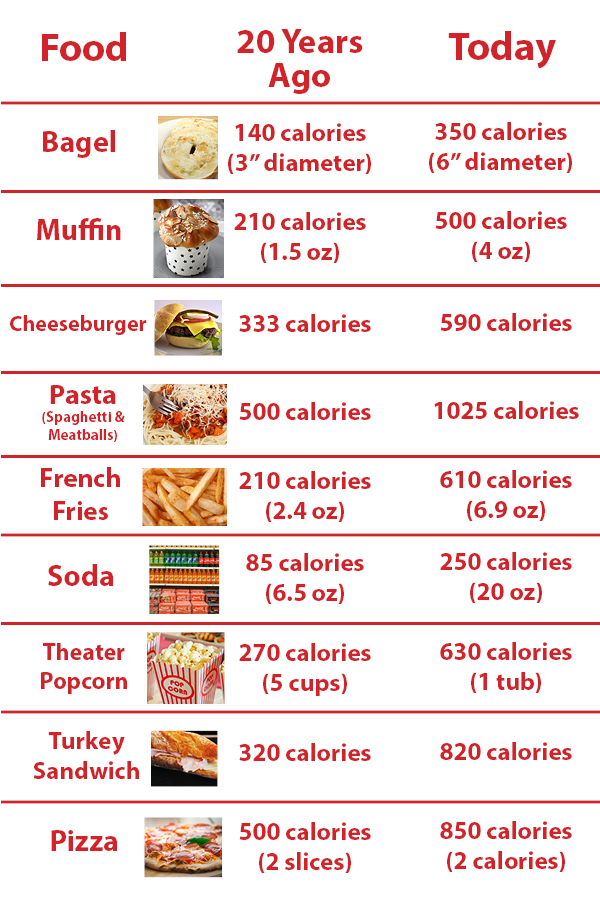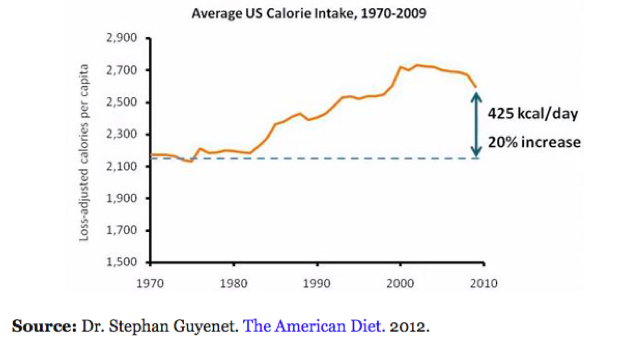Everywhere you look, something new is blamed for America’s obesity crisis. “We are eating too much and moving too little.” “It is due to our stress and our lack of sleep.” “We are dining in our car, eating on the run and choosing foods from a box or a fast food restaurant over healthy, homemade meals.
Yesterday, fat was to blame, and today it is sugar. As we search for the truth on how to keep our families healthy, it is impossible to ignore some of the more obvious changes taking place in our food-filled environment — especially as it pertains to portion sizes.
Over the last twenty years, the American diet has changed dramatically both in terms of the quantity and quality of our food intake. In 1970, Americans took in an average of 2,160 calories per day. Today, it has skyrocketed to 2,673 daily calories per person. As shown in the graph below, we are now eating 20-25 percent more calories than we did in 1970!
How did this happen? Interestingly, both plate sizes and portion sizes expanded before our eyes. With the introduction of processed, shelf-ready food in combination with new agriculture policies, food became cheaper and easier to get our hands on than it was in the 1970s. If you combine this with a society that is always looking to get a bang for their buck, you end up with price wars over who can give you the most food for the least amount of money.
Whether you choose to get “supersized” meals at McDonalds, or have the “all you can eat pasta” at Olive Garden, what value-based pricing saves you in cash today may get you tomorrow with the cost of medications and hospital bills.
As the Washington Post showed in the diagram below, many of the meals we are eating out at restaurants contain as many calories as we need in an entire day. Research has shown, that the more often you eat out or on the road, the more weight you gain.

If we look at individual foods and compare calories from the 1970s and 1980s to today, it is really telling. The National Heart, Lung and Blood Institute (NHLBI) has a quiz on their website that every American should take, detailing the tremendous changes in portion sizes over the years. Take the quiz for yourself — the answers will shock you!
Here is a summary of how some of our favorite foods have changed:

Unfortunately, it is not just the quantity of food we are eating that is the problem; it is also the quality or macronutrients, such as fat, carbohydrates and protein. Unlike lean protein, which tends to help increase muscle mass, the added calories in our diet have been made up of grains, sugars, and unhealthy fats. Our body can only store so much glucose (the breakdown products of carbohydrates) as energy. The remainder is stored in the liver and fat cells in an unhealthy manner, creating inflammation and contributing to diseases such as high blood pressure, high cholesterol and diabetes.
Given that news, what can we do to help our families stay healthy, or improve our health in this kind of environment?
Here are a few tips to help every family survive and thrive when it comes to portion sizes:
- When eating out, ask for a to-go box and take half of your meal home.
- Try to order protein, such as meat or fish, or plant-based food such as tofu, over carbohydrates such as pasta, rice and potatoes.
- When eating out, ask to hold the starch (pasta, potatoes, rice) and double up on the veggies.
- When serving food at home, use smaller plates for the main course, and larger ones for the salad.
- When eating at home, try to buy fresh, local produce in season. Stay away from processed foods as much as possible.
- When plating your food, make half of the plate veggies and salad. The other half should be split into 2/3 protein, and 1/3 carbs. The starchy carb items should be the smallest part of your plate.
- Have your family get up and serve themselves. Do not leave the food on the table, or everyone will eat more.
- When lured by more food for less money, look to see if they are just adding more starch (pasta, French fries or rice). If this is the case, don’t bite!
- Limit eating out to no more than once per week, and try to cook more healthy meals at home.
- When eating, just eat! Refrain from watching TV, using electronics or reading a magazine or book.
About the Author:
 Dr. Wendy Scinta, MD, MS, is a nationally recognized expert on adult and childhood obesity treatment, and the current president-elect of the Obesity Medicine Association. She is also a Clinical Assistant Professor of Family Medicine at SUNY Upstate, Diplomat of the American Board of Family Physicians and the American Board of Obesity Medicine. Dr. Scinta’s BOUNCE childhood obesity program has been researched and implemented internationally. Her practice, Medical Weight Loss of New York, has treated thousands of individuals, from 4 to 84 years of age, helping several lose in excess of 200 pounds.
Dr. Wendy Scinta, MD, MS, is a nationally recognized expert on adult and childhood obesity treatment, and the current president-elect of the Obesity Medicine Association. She is also a Clinical Assistant Professor of Family Medicine at SUNY Upstate, Diplomat of the American Board of Family Physicians and the American Board of Obesity Medicine. Dr. Scinta’s BOUNCE childhood obesity program has been researched and implemented internationally. Her practice, Medical Weight Loss of New York, has treated thousands of individuals, from 4 to 84 years of age, helping several lose in excess of 200 pounds.
Dr. Scinta is the weight-loss expert for the Steve Harvey Show, and has been featured on air by CNN, Voice of America, John Tesh Intelligence for you Health, Say Yes To the Dress: Big Bliss Edition on TLC, PBS, as well as in print including AMA News, The Denver Post, MD News, Newsday, The New York Times, The Wall Street Journal, Parenting, Bariatric Times, Your Weight Matters, Web MD, Woman’s Day, and Woman’s Health Magazine, among others. She also recently appeared in the 2014 documentary, “Carb Loaded- A culture dying to Eat.” Dr. Scinta earned her medical degree from Upstate Medical School in Syracuse, and performed her residency in family medicine at Duke University.








3 thoughts on “The History of Portion Sizes: How They’ve Changed Over Time”